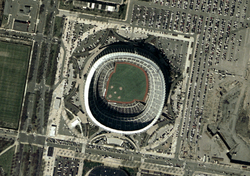Bounty Bowl I: The 1989 Thanksgiving Classic
 Texas Stadium, the site of the game. | |||||||||||||||||||
| |||||||||||||||||||
| |||||||||||||||||||
| Date | November 23, 1989 | ||||||||||||||||||
|---|---|---|---|---|---|---|---|---|---|---|---|---|---|---|---|---|---|---|---|
| Stadium | Texas Stadium Irving, Texas | ||||||||||||||||||
| Favorite | Philadelphia -6 [1] | ||||||||||||||||||
| Referee | Gene Barth | ||||||||||||||||||
| TV in the United States | |||||||||||||||||||
| Network | CBS | ||||||||||||||||||
| Announcers | Pat Summerall and John Madden | ||||||||||||||||||
The Cowboys/Eagles rivalry had been increasingly heated since the 1986 season, with Buddy Ryan arriving as the Eagles' head coach; the next year, during the NFL players' strike, the Cowboys (who were playing with a number of players that crossed picket lines) routed an Eagles squad filled with replacement players; [2] Ryan, believing that the Cowboys had run up the score in poor form, responded in kind in the second game when the strike was over. [3] After the 1988 season, the Cowboys were sold to Jerry Jones, who proceeded to gut the team and fire longtime head coach Tom Landry in preparation for rebuilding.
On November 23, 1989, the Philadelphia Eagles defeated the Dallas Cowboys 27–0. Following the game, which was broadcast on CBS, Cowboys head coach Jimmy Johnson alleged that Ryan had taken out a bounty on two of the former's players, kicker Luis Zendejas and quarterback Troy Aikman: [4]
I have absolutely no respect for the way they played the game, I would have said something to Buddy, but he wouldn't stand on the field long enough. He put his big, fat rear end into the dressing room.
Ryan denied the bounty accusation, saying that film of the game "show that Small had no intention of hurting Zendejas." [5] The Philadelphia coach asserted it would have been in the Eagles' best interests to keep Zendejas in the game because he was in a slump. [5] Ryan also joked about Johnson's accusations: [5]
I resent that. I've been on a diet, I lost a couple of pounds, and I thought I was looking good.
When the Cowboys and Eagles met on Thanksgiving 25 years later, on November 27, 2014, Johnson joked that Ryan put up the bounty offer to keep his players interested since the Cowboys, who ultimately went 1-15, performed so poorly that year. [6]
Zendejas spoke of having seen ''Buddy call guys out and give them $100'' for what the kicker called a weekly Big Hit award but what Ryan called a Big Play award. [7] This set of events set the stage for the scheduled rematch two weeks later in Philadelphia, dubbed "Bounty Bowl II." As for the Eagles, they would not play another Thanksgiving game until the 2008 NFL season when the Eagles faced the Arizona Cardinals in a preview of that season's NFC Championship Game.
